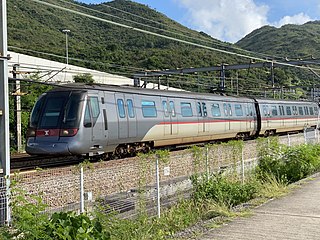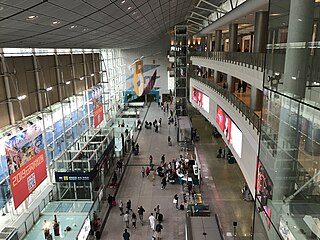
Hong Kong has a highly developed transport network, encompassing both public and private transport. Based on Hong Kong Government's Travel Characteristics Survey, over 90% of daily journeys are on public transport, the highest rate in the world. However, in 2014 the Transport Advisory Committee, which advises the Government on transportation issues, issued a report on the much-worsened congestion problem in Hong Kong and pointed at the excessive growth of private cars during the past 10–15 years.

Hong Kong Island is an island in the southern part of Hong Kong. The island, known originally and on road signs simply as "Hong Kong", had a population of 1,289,500 and a population density of 16,390 per square kilometre (42,400/sq mi), as of 2008. The island had a population of about 3,000 inhabitants scattered in a dozen fishing villages when it was occupied by the United Kingdom in the First Opium War (1839–1842). In 1842, the island was formally ceded in perpetuity to the UK under the Treaty of Nanking and the City of Victoria was then established on the island by the British Force in honour of Queen Victoria. The Central area on the island is the historical, political and economic centre of Hong Kong. The northern coast of the island forms the southern shore of the Victoria Harbour, which is largely responsible for the development of Hong Kong due to its deep waters favoured by large trade ships.

Lantau Island is the largest island in Hong Kong, located west of Hong Kong Island and the Kowloon Peninsula, and is part of the New Territories. Administratively, most of Lantau Island is part of the Islands District of Hong Kong. A small northeastern portion of the island is located in the Tsuen Wan District.

The Islands District is one of the 18 districts of Hong Kong. It is part of the New Territories. It had a population of 185,282 in 2021.

Hong Kong International Airport is an international airport located on the island of Chek Lap Kok in western Hong Kong. The airport is also referred to as Chek Lap Kok International Airport or Chek Lap Kok Airport, to distinguish it from its predecessor, the former Kai Tak Airport.

The Tsuen Wan line is one of the ten lines of the metro network in Hong Kong's MTR. It is indicated in red on the MTR map.

Tung Chung, meaning "eastern stream", is an area on the northwestern coast of Lantau Island, Hong Kong. One of the most recent new towns, it was formerly a rural fishing village beside Tung Chung Bay, and along the delta and lower courses of Tung Chung River and Ma Wan Chung in the north-western coast of Lantau Island. The area was once an important defence stronghold against pirates and foreign military during the Ming and the Qing dynasties.

The Tung Chung line is one of the ten lines of the MTR system in Hong Kong, linking the town of Tung Chung with central Hong Kong. It was built in the 1990s as part of the Airport Railway project, part of the construction of the new Chek Lap Kok Airport. The line currently travels through eight stations in 31 minutes along its route. The line is coloured orange on the MTR system map.

Chek Lap Kok is an island in the western waters of Hong Kong's New Territories. Unlike the smaller Lam Chau, it was only partially leveled when it was assimilated via land reclamation into the 12.48 square kilometres (4.82 sq mi) island for the current Hong Kong International Airport, which opened for commercial aviation in 1998. The airport is popularly referred to as Chek Lap Kok Airport to distinguish it from the former Hong Kong International Airport, now commonly known as Kai Tak Airport (啟德機場).

The Airport Express is one of the ten lines of the Hong Kong MTR system. It links the urban area with Hong Kong International Airport and the AsiaWorld–Expo exhibition and convention centre.
Gammon Construction Limited is a Hong Kong construction and engineering contractor headquartered in Kwun Tong, Hong Kong. In addition to local construction projects, it is also involved in the construction and engineering of various projects in China and Southeast Asia.

Hong Kong is a station of the MTR metro system in Hong Kong. It is the eastern terminus of the Tung Chung line and Airport Express. It is situated between Man Cheung Street and Harbour View Street, Central, Hong Kong Island, and sits underneath the International Finance Centre (IFC). It opened on 22 June 1998.

Ngong Ping 360 is a bicable gondola lift on Lantau Island in Hong Kong. Intended to improve tourism to the area, the aerial lift was previously known as Tung Chung Cable Car Project before acquiring the Ngong Ping 360 brand in April 2005. It consists of the Ngong Ping Cable Car, formerly known as the Ngong Ping 360 Skyrail, and the Ngong Ping Village, a retail and entertainment centre adjacent to the cable car's upper station. Ngong Ping 360 connects Tung Chung, on the north coast of Lantau and itself linked to central Hong Kong by the Tung Chung line, with the Ngong Ping area in the hills above. This is home to the Po Lin Monastery and the Tian Tan Buddha, both already significant tourist attractions in their own right. Before Ngong Ping 360's opening, the only access was via a mountain road and bus service.

The Airport Core Programme was a series of infrastructure projects centred on the new Hong Kong International Airport during the early 1990s. The programme was part of the Port and Airport Development Strategy, commonly known as the Rose Garden Project.

North Lantau Highway is an expressway forming part of Hong Kong's Route 8, linking Hong Kong International Airport and Lantau Island with the rest of the territory. The road has three lanes in each direction for its entire length with full-width hard shoulders for emergencies and breakdowns. The speed limit is 110 kilometres per hour (68 mph) for most of its length, the highest of any road in Hong Kong.

Ma Wan Viaduct is a viaduct built over Ma Wan, an island in Hong Kong. The viaduct connects the Tsing Ma Bridge and Kap Shui Mun Bridge with an exit to Ma Wan Road, and is part of the Lantau Link and Route 8. It was opened on 22 May 1997 and was built to provide access to the Hong Kong International Airport as part of the Airport Core Programme.

Siu Ho Wan is a bay on the north shore of Lantau Island in Hong Kong. The bay has been largely reclaimed for bus depots. The Airport Express, Tung Chung line of the MTR and the North Lantau Highway run across the reclamation of the bay. The Siu Ho Wan MTR depot lies on the reclaimed shore between Ngau Kok Wan and is currently used by Airport Express, Tung Chung line and Disneyland Resort line.
Articles related to Hong Kong include:














